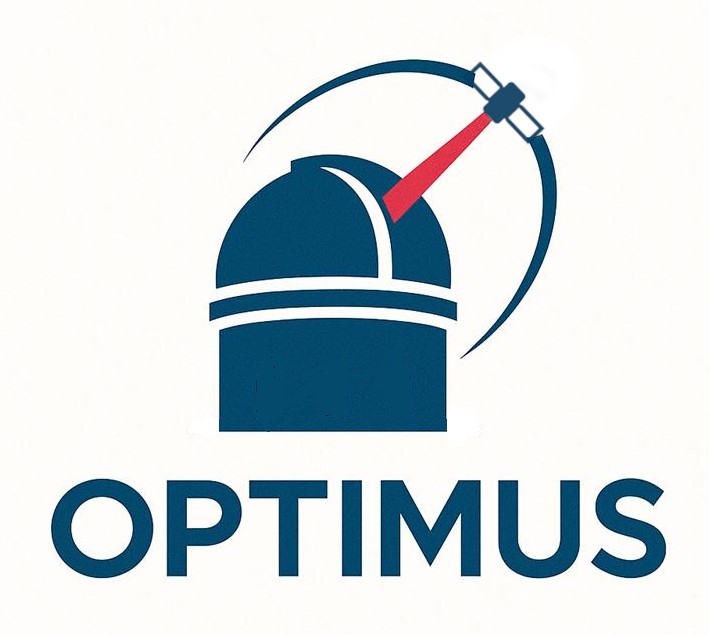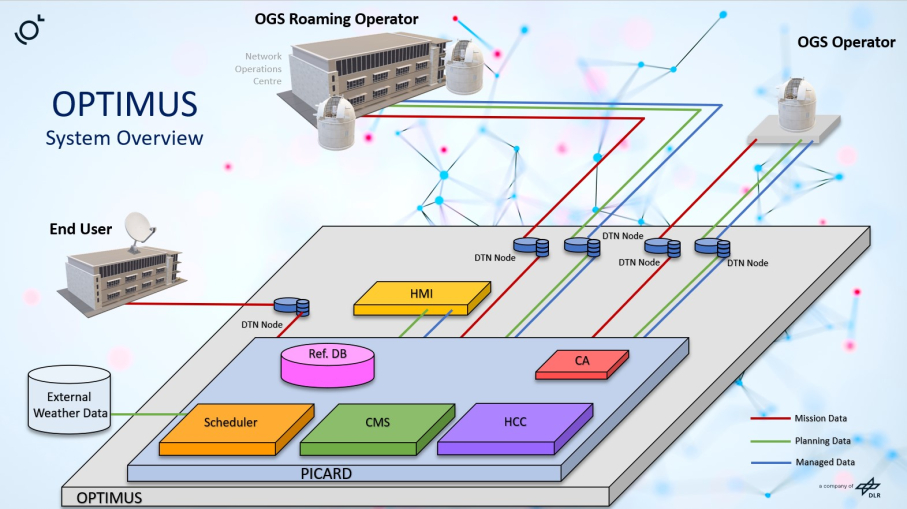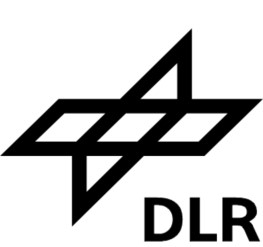
-
StatusOngoing
-
Activity Code6B.128
The OPTIMUS test bench establishes a foundation for next-generation optical communication services by demonstrating robust, user-driven capabilities in scheduling, data delivery, and network monitoring. It enables seamless registration of OGS, Network Operations Centers (NOCs), and satellite operators via a lightweight, harmonised process that ensures interoperability across diverse optical systems. By implementing a “NOC of NOCs” architecture, OPTIMUS centralises planning and resource management to maximise pass reliability and data throughput. The platform integrates Human-Machine Interface, planning algorithms, real-time monitoring, and networking modules into a cohesive framework, supporting both single- and multi-OGS scenarios under realistic operational conditions.
OPTIMUS also serves as a reference for standardisation and can host advanced use cases such as quantum key distribution and quantum communication experiments. Through rigorous requirement refinement, design finalisation, and targeted validation tests, the project raises the solution’s Technology Readiness Level and prepares it for seamless integration into operational environments - laying the groundwork for scalable, cost-effective Optical Communications as a Service.

The project navigates three key challenges: integrating a still-maturing Disruption Tolerant Networking (DTN) protocol end-to-end - requiring protocol conversion and satellite-simulator support; coordinating diverse subsystems (planning, HMI, DTN, HCC, monitoring) developed by multiple teams using agile methods and clear workflows; and balancing cost-driven design constraints by leveraging open-source software, consortium expertise, and careful trade-offs to contain development, licensing, and integration expenses.
OPTIMUS delivers a unified, end-to-end optical communications testbed that surpasses existing solutions by combining modularity, interoperability, and real-time automation in a single platform. Unlike siloed ground-station tools, OPTIMUS harmonises OGS, NOC, and customer registration through a lightweight process that enforces common data models and protocols - minimising onboarding friction across diverse vendor systems. Its “NOC of NOCs” architecture centralises planning and resource management, enabling dynamic pass scheduling across multiple stations with built-in cost and link-budget optimisation.
Integrated DTN support and realistic emulation capabilities allow true E2E validation under network impairments, a capability missing in most competitor offerings. Native real-time monitoring and an extensible HMI provide comprehensive situational awareness and control, reducing operational risk. By leveraging open-source components and consortium expertise, OPTIMUS achieves these features at lower total cost of ownership, while its standards-based interfaces ensure future extensibility - positioning it as the de facto platform for scalable, multi-operator optical communications services.
OPTIMUS comprises five core modules that deliver its advanced capabilities:
- Human-Machine Interface (HMI)
Provides a unified web portal for OGS, NOC, and customer registration; pass requests; simulation control; and secure data retrieval, with role-based access and real-time visualisation. - Scheduler & Optimisation Engine
Automates pass processing and dynamic rescheduling, ranking slots via link-budget, cost, and visibility analyses, and adapting to maintenance, weather, or network outages. - Holistic Control Centre (HCC)
Establishes a common infrastructure framework - composed of core services for security, data transport, configuration, logging, and run-time life-cycle management - and extensible application components. - Emulator
Simulates spacecraft-to-OGS interactions under configurable impairments (latency, packet loss, handovers), enabling end-to-end validation and early fault detection. - Central Monitoring System (CMS)
Aggregates telemetry, status feeds, and performance metrics; drives alerting and historical trend analysis via a unified dashboard.
Underpinning these modules is DTN integration, fragmenting and securely forwarding data bundles to ensure resilience against connectivity disruptions. All components communicate over standardised, secure APIs and message buses, enabling modular upgrades, multi-operator scalability, and the reliable, cost-effective optical communications services that OPTIMUS provides.
The Testbed adopts a modular, service-oriented architecture comprising five key components interconnected by secure, standardised interfaces:
- Human-Machine Interface (HMI) serves as the entry point for operators and customers, providing registration, scheduling, simulation control, and data retrieval.
- Scheduler & Optimisation Engine processes pass requests, applies link-budget and cost-based ranking, and handles dynamic rescheduling. It exposes REST endpoints and publishes scheduling events to an internal message bus.
- Holistic Control Centre (HCC) serves as a middleware as it provides within OPTIMUS the ability to dynamically connect OGS or OGS-networks. OGSs can connect to the entire system as new services and HCC provides the needed infrastructure to provide coherent configurations, security and so on.
- Emulator consumes scheduling events to drive spacecraft-to-ground interaction scenarios under configurable impairments (latency, packet loss, handover), streaming telemetry results to the monitoring layer.
- Central Monitoring System (CMS) subscribes to health and performance topics on the message bus, aggregates metrics in a time-series database, and pushes alerts and trend data to the HMI.
A DTN integration layer underlies data transfers, segmenting and forwarding bundles over intermittent links. The architecture enables independent development, easy scalability to multiple operators, and robust validation of optical communication workflows.

The project unfolds in five phases, each ending with a formal milestone review:
- Preparation - Project Kick-Off (KO) and State-of-the-Art/Trade-Off studies, concluding with the Preliminary Design Review (PDR).
- Design - Architecture and ICD alignment, ending at the Critical Design Review (CDR).
- Build - Module implementation and system integration, culminating in the Factory Test Readiness Review (FTRR).
- Test - System and interface validations (including remote OGS), fixes applied, ready for the Test Readiness Review (TRR).
- Operate - Operational demonstrations and final handover at the Final Review (FR).
The project is in the Preparation phase, having completed the Kick-Off and initiated State-of-the-Art studies and technology trade-off analyses. Core activities include defining detailed user scenarios, refining high-level requirements, and setting up development environments. Upcoming tasks focus on finalising the Preliminary Design Review inputs, solidifying the ICD framework, and aligning stakeholder workflows to ensure a smooth transition into the Design phase.






